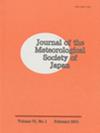大气-波浪-海洋耦合模式模拟的台风Lionrock(2016)衰减期对流爆发与强度变化的关系
IF 1.6
4区 地球科学
Q3 METEOROLOGY & ATMOSPHERIC SCIENCES
引用次数: 6
摘要
台风Lionrock(2016)在日本北部太平洋一侧登陆。其中一个有趣的事件是在8月31日登陆之前发生了连续的深层对流(对流爆发,CBs)。Lionrock暂停了风暴强度的衰减,尽管沿轨道的海面冷却(SSC)明显是由Lionrocke引起的。为了研究CB对衰减阶段风暴强度变化的影响,使用3公里网格耦合大气-波浪-海洋模型进行了数值模拟。耦合模型成功地模拟了近表面辐合区以北的CB的出现,该辐合区是由风暴的切向风与来自有效波高较高的周围区域的近表面摩擦螺旋流汇合而形成的。同时,保持了相对快速的平移和不对称的热带气旋结构。辐合区周围较低的对流层水平湿气通量有所增强,尽管SSC导致风暴内核内的海气潜热通量减少。与CB相关的向上湿气通量的局部出现增加了上游侧对流层中上层的冷凝加热。这导致上游侧对流层低压梯度局部增加。这有利于暂停模拟风暴强度的衰减,即使在衰减阶段也是如此。关于耦合模型执行时间的敏感性实验表明,当不使用耦合模型时,风暴前表面摩擦辐合区周围的垂直水分通量和CB数量可能会增加。这表明,在有利的海洋条件下,中纬度风暴可能会局部增加最大表面风速。CB的数量和分布确实对海洋条件很敏感,并被认为会影响风暴路径模拟和最大表面风速。本文章由计算机程序翻译,如有差异,请以英文原文为准。
Relation of Convective Bursts to Changes in the Intensity of Typhoon Lionrock (2016) during the Decay Phase Simulated by an Atmosphere-Wave-Ocean Coupled Model
Typhoon Lionrock (2016) made landfall in the Pacific side of northern Japan. One of the intriguing events was consecutive deep convections (convective bursts, CBs) occurred before making landfall on 31 August. Lionrock paused the decay of the intensity of the storm, although sea surface cooling (SSC) was induced distinctly by Lionrock along the track. To examine the influence of CBs on changes in storm intensity during the decay phase, numerical simulations were conducted with a 3 km mesh coupled atmosphere-wave-ocean model. The coupled model successfully simulated the occurrence of CBs north of the near-surface-convergence area, which was formed by the confluent of the storm’s tangential winds with near-surface frictional spiral inflow from the surrounding region where the significant wave height was high. Simultaneously, the relatively fast translation and asymmetric tropical cyclone (TC) structure were maintained. Lower tropospheric horizontal moisture fluxes have enhanced around the convergence area, although SSC resulted in reduction of the air-sea latent heat fluxes within the storm’s inner core. Local occurrences of upward moisture fluxes associated with CBs increased the mid-toupper tropospheric condensational heating on the upstream side. This caused local increase in lower-tropospheric pressure gradient on the upstream side. This was favorable for pausing the decay of the simulated storm intensity even during the decay phase. Sensitivity experiments regarding the execution time of the coupled model showed that the vertical moisture fluxes and number of CBs could increase around the surface frictional convergence area ahead of the storm when the coupled model was not used. This suggests that the storm in mid-latitude could locally increase the maximum surface wind speed under favorable oceanic conditions. The number and distribution of CBs are indeed sensitive to oceanic conditions and are considered to affect the storm-track simulation and maximum surface wind speeds.
求助全文
通过发布文献求助,成功后即可免费获取论文全文。
去求助
来源期刊
CiteScore
6.70
自引率
16.10%
发文量
56
审稿时长
3 months
期刊介绍:
JMSJ publishes Articles and Notes and Correspondence that report novel scientific discoveries or technical developments that advance understanding in meteorology and related sciences. The journal’s broad scope includes meteorological observations, modeling, data assimilation, analyses, global and regional climate research, satellite remote sensing, chemistry and transport, and dynamic meteorology including geophysical fluid dynamics. In particular, JMSJ welcomes papers related to Asian monsoons, climate and mesoscale models, and numerical weather forecasts. Insightful and well-structured original Review Articles that describe the advances and challenges in meteorology and related sciences are also welcome.

 求助内容:
求助内容: 应助结果提醒方式:
应助结果提醒方式:


